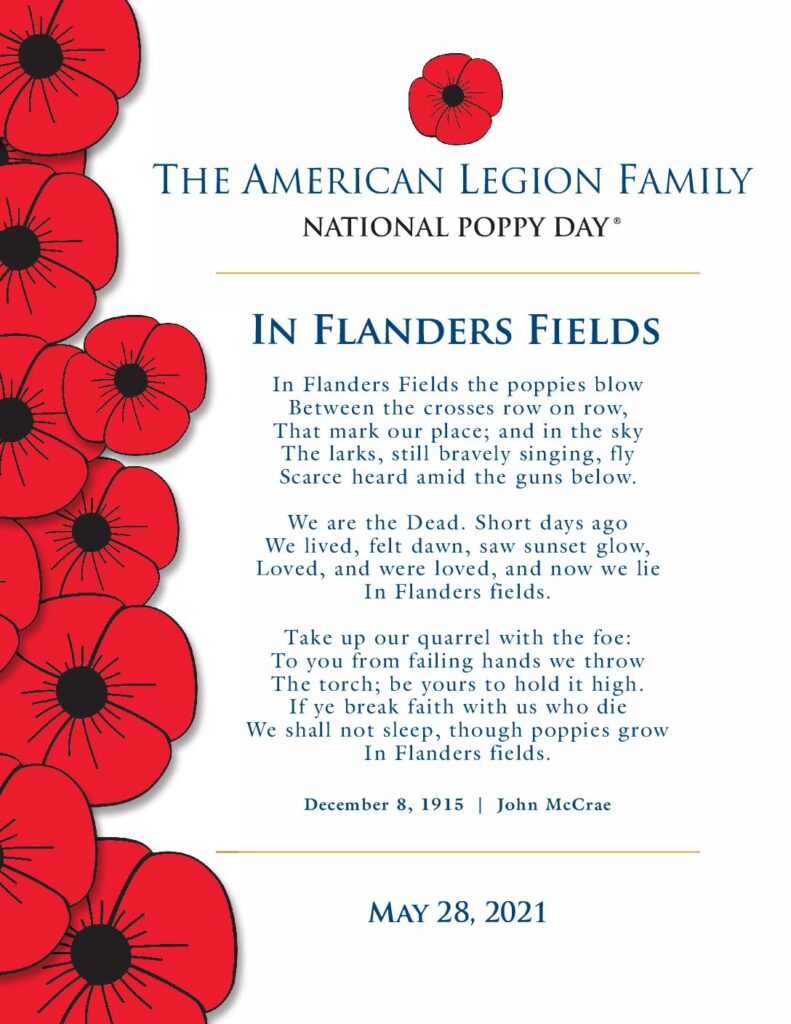Apr 24, 2023
Why The Poppy?

Have you ever seen people, usually women, in front of stores selling paper poppies? Have they encouraged you to wear it on your lapel? What is this all about?
Scientists believe that soil in Belgium and France became enriched with lime due to the shelling in WWI. This is where the major battles, trench warfare grinding on in one place for months, took place over 4 years. The red poppy flourished in this new soil that was so churned up. It is this poppy that inspired Canadian Lt. Col. John McCrae to write his famous poem “Flanders Fields” in 1915. As a doctor he had been attending to the severely wounded soldiers. He was mourning the recent death of a close friend in the battle that had killed 87,000. He was worn out. He rested in the back of a truck parked near some bomb craters. He noticed red poppies nodding here and there like blood sprinkled in the dirt. That scene was the impetus for his poem written on the back of some scrap paper. In a weary voice he challenges us to take up the fight for freedom that so many had already given their lives for. Asking future readers to protect freedom in their day.
The poem was published in many magazines in the United States. It was read at countless memorial services. A Georgia college professor, Mona Michael, read the poem. She was inspired by the significance of the red poppy: resilience, hope, honor and peace. She vowed to wear it all the time and made them from fabric to give to friends. Mona lobbied the Georgia chapter of the American Legion to adopt it as a symbol of remembrance. She was successful and encouraged by that success she lobbied the national American Legion. On September 27, 1920 the little red poppy became the official flower of the American Legion as the national emblem of remembrance. In 1924 distribution of the poppy became a national program of the American Legion. The American Legion commemorates the Friday before Memorial Day as Poppy Day. This is when you will see Auxiliary members, the Women’s Section of the American Legion, offering poppies in shopping areas seeking donations to help remember the fallen and to help veterans with their health needs. From the fields of Belgium and France in WWI to today in the United States the poppy is the national symbol of hope, resilience, remembrance and honor worn on Memorial Day and on Veteran’s Day.
Poppies are a symbol of honor for the WW I fallen in many countries worldwide. Remembrance Day, first known as Poppy Day in the British Commonwealth and in many European countries, is commemorated on November 11th. The whole Commonwealth, lead by the royal family, attends services wearing the poppy to remember the sacrifices of WWI. Poppy floral arrangements and wreaths are used as tributes. Poppy jewelry is very poplar and can be very elaborate. There are many websites across Britain and Europe that sell beautiful poppy jewelry to be worn in remembrance. Remembrance Day in 2014 was especially meaningful in London as they mourned the beginning of WWI. As a commemorative art project created by artist Paul Cummins and Tom Piper, artists were asked to create ceramic poppies to fill the moat around the Tower of London. 888,246 ceramic poppies were made and donated to progressively fill the moat at the Tower of London between July and November 21,688 people volunteered to install the poppies. Each poppy represented a British military fatality during WWI. From November 5 – 11, 2018 the moat was filled with 10,000 torches to commemorate the end of the war. It took Beefeaters and volunteers less than an hour to light all of the torches nightly during that time.
If you see someone offering flower poppies, make a donation and put it in your lapel. Plant some red poppies in a planter. Give a package of red poppy seeds to a friend. By displaying the little red poppy you wil be honoring all those who have gone before us on Memorial Day. On Veteran’s Day we honor the 53, 402 Americans who died in combat and the 45,000 service men and women who died of the flu and pneumonia in service to their country during WWI and subsequent wars.
Read the poem, the origin story of the poppy, below.
This article was taken from information from the Good Housekeeping article “Everything You Need to Know About the Symbolism Behind the Memorial Day Poppies” found online at www.goodhousekeeping.com; the History Channel and the American Legion website.
